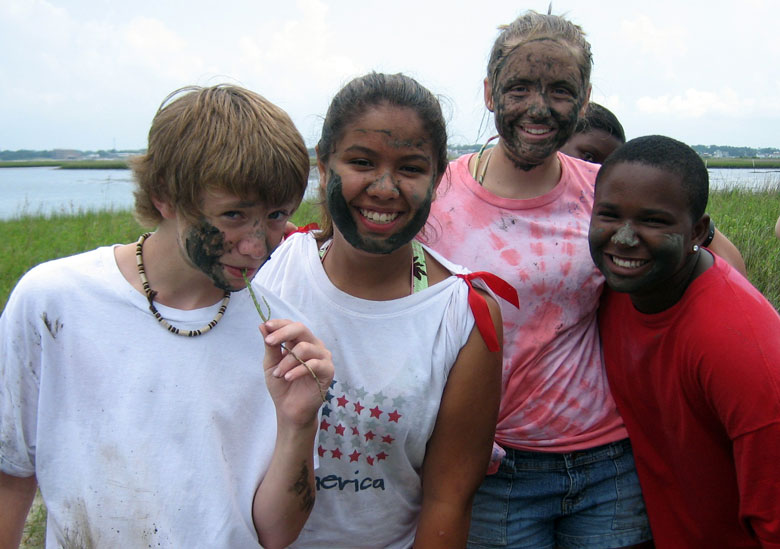The federation’s three educators like to take kids outside, get them dirty and teach them about the state’s coastal environment
SWANSBORO — Wayne Guthrie points to a set of deer tracks on the sandy beach of Jones Island and calls out to a group of young teenagers to take a look.
Supporter Spotlight
But not one single kid pays attention. They are too busy grabbing up dibblers and plugs of salt marsh cordgrass for replenishing the soggy wet sand along the water.
Guthrie, owner of Outer Banks Seafood in Beaufort, gives up on the deer tracks, picks up a dibbler and joins his twin daughters, Cassandra and Nadine, who have already started digging.
This group is part of the Beaufort Middle School Envirothon Club, devoted to creating and preserving the environment at their school, in their community and beyond. On a day in April, they are hard at work restoring the wetlands on Jones Island.
The club is tailor made for the N.C. Coastal Federation’s educational programs. Public schools up and down the coast have been coordinating with the federation for nearly a decade to help restore shorelines, build oyster reefs and contain polluted runoff with rain gardens.
Sarah Phillips, education coordinator for the central coastal region for the past eight years, loves working with the middle school students.
Supporter Spotlight
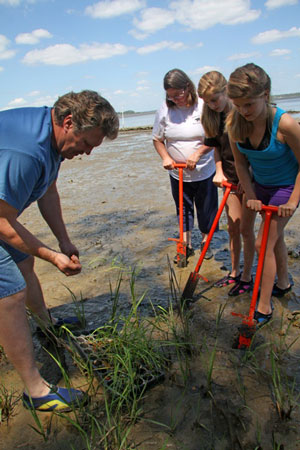
Wayne Guthrie helps, from left, his daughters Nadine and Cassie and their adviser Josie Boyette plant grass on Jones Island. Photo: Teri Saylor |
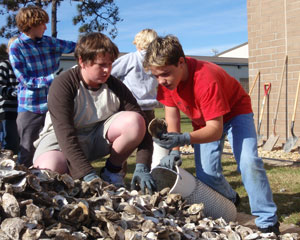 Students from Alderman Elementary School in Wilmington create bags of oyster shells that are used to build reefs. |
“The wetlands restoration program is a perfect fit for the seventh and eighth graders,” Phillips says. “The things they are learning fit into their standard curriculum as mandated by the state, and it dovetails with their testing.”
From August through May, students and teachers study and learn. Teachers are schooled in the program, lesson planning and curriculum. Students learn marshland ecology, build on-campus nurseries and learn to germinate seeds and grow cordgrass. The year culminates in a daylong field trip where they plant grasses and perform biological monitoring.
The federation also has education coordinators in Manteo on the northeast coast and in Wrightsville Beach on the southern coast. All three educators work with nearly 2,000 students each year on various coastal restoration projects — planting marsh grasses, building oyster beds and cultivating rain gardens. They visit another 3,000 kids in the classrooms each year.
“Good teachers are the key to our work,” says Sara Jean Hallas, coastal education coordinator for the northeast region. “Their willingness for our programs to take place is essential. Most of our programs fall within state curriculum guidelines, but not all teachers see that.”
Kitty Hawk Elementary school is a success story.
“We worked through the entire K-5 elementary school on our rain garden project, and it worked,” Hallas reports. “The school is on board.”
Based on the success of a school rain garden, the Kitty Hawk Elementary School PTA formed a Green Team, applied for and received grant funding to build a greenhouse.
“They are building the greenhouse now,” says Hallas.
Back on Jones Island, 22 young ecologists are hard at work, using their dibblers to dig deep holes in sand so thick and boggy, it threatens to suck the shoes right off their feet.
Working quickly, in pairs, the teenagers alternate digging holes and filling them with cordgrass plugs.
Spencer Valentine, 14, demonstrates the correct way to plant the grass plugs, close together.
“The closer, the better,” he says. “If they are close, they hold the soil together better.”
This event marks Bree Kerwin’s first time volunteering. She is a freelance environmental science consultant who lives in nearby Pine Knoll Shores.
“The more interested the kids are, the more they want to help as adults,” Kerwin says.
And that is music to Phillips’ ears. “Habitat restoration teaches stewardship by having students get out and do the work,” she says. “Hopefully they will become stewards of the wetlands environment as adults too.”
When these middle school students get to high school, they will be able to participate in the federation’s oyster education and restoration program, alongside their own school’s environmental science and biology studies.
The federation’s educational programs also touch younger kids.
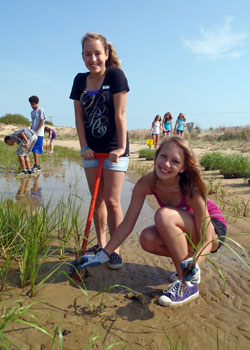 Students at First Flight Middle School in Kill Devils Hills plant marsh grasses at Jockey’s Ridge State Park. |
At elementary schools up and down the coast, the federation helps youngsters design, build, plant and maintain rain gardens on their campuses to reduce pollution and flooding and to serve as living classrooms.
Outdoor classrooms are a treat for adults as well as students.
“I love doing this,” Phillips says. “It’s great teaching outside.”
Ted Wilgis has worked with the federation for over a decade, after a nine-year stint managing the Chesapeake Bay Foundation’s educational programs. As coastal education coordinator in the federation’s southeast region, Wilgis focuses on oyster restoration programs in addition to other educational endeavors.
Over the years, he has helped shepherd the federation’s educational programming from a celebration of the coast’s beauty, to a multi-pronged approach that helps young people become good custodians of the environment.
“We have identified five tools to help students learn to make informed decisions and take action,” Wilgis says. “Those tools are awareness, critical thinking, problem solving and stewardship.”
Wilgis has a favorite slogan: “No child left inside.”
His mission is to encourage young people to get outside and connect with their surroundings.
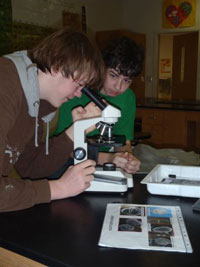 First Flight students study the biology of oysters. |
“Education is incredibly important. It makes it easier for kids to get involved as adults,” he says. “We’re not advocates in the classroom. We teach about coastal ecology. We don’t advocate for a specific position about the coast, but we do provide resources for students to make their own decisions.”
The Beaufort Middle School environmentalists are inspired.
Rachel Ellis, 14, loves working on Jones Island.
“Down where I live, way down in South River, I see trash on the roads,” she says. “I want to learn about helping the environment.”
After the planting is done, the marsh is a muddy landscape of sparse grass. Eventually it will fill out until it matches an area of lush growth where students planted cordgrass last year.
The students take up dip nets and a casting net and cringe as they wade waist deep into the chilly water just off the beach. They are catching small salt water critters for identification.
Wayne Guthrie is as excited as his daughters to be there. He enjoys volunteering and helping.
“Kids should keep participating and doing things to help the environment,” he says. “This is their future.”

